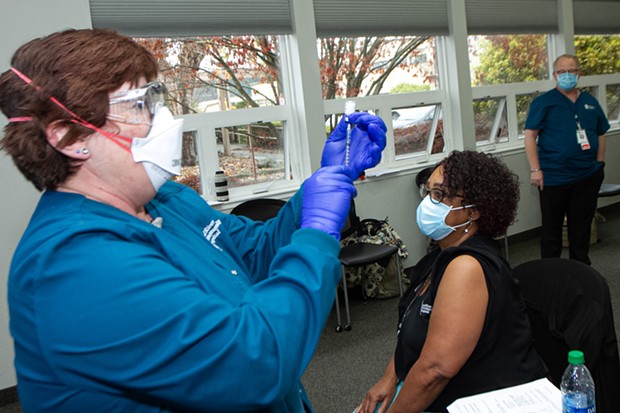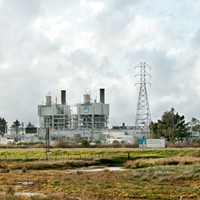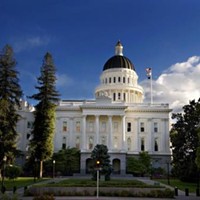Friday, January 8, 2021
California's New Goal: 1 Million Vaccinations in 10 Days
Posted By Barbara Feder Ostrov/CalMatters on Fri, Jan 8, 2021 at 11:03 AM
Getting the coronavirus vaccines into the arms of as many Californians as possible has become a race against time as COVID-19 cases continue to spiral upward and a more infectious variant of the virus takes root.
Many questions remain unanswered about how the next — and much larger — wave of Californians will be vaccinated, even as doctors and other health providers in the first priority group are complaining to state officials that they still can’t get access to the vaccines.
At a vaccine community advisory committee meeting on Wednesday, state epidemiologist Dr. Erica Pan announced an ambitious immunization goal, acknowledging widespread criticism that the state has moved too slowly to vaccinate its first priority group of frontline health care workers and nursing home residents. California now aims to immunize 1 million people within the next 10 days, Pan said.
Officials are recruiting dentists and other health professionals to become vaccinators, and Gov. Gavin Newsom asked state lawmakers to approve $300 million to support the vaccination push.
“We do need to move faster,” Pan said, “especially in the middle of this surge.”
Nearly 530,400 doses of either the newly authorized Pfizer or Moderna vaccines had been given by the end of Wednesday, just over a quarter of the more than 2 million doses shipped to California hospitals and county health departments.
Many questions remain unanswered about how the next — and much larger — wave of Californians will be vaccinated, even as doctors and other health providers in the first priority group are complaining to state officials that they still can’t get access to the vaccines.
At a vaccine community advisory committee meeting on Wednesday, state epidemiologist Dr. Erica Pan announced an ambitious immunization goal, acknowledging widespread criticism that the state has moved too slowly to vaccinate its first priority group of frontline health care workers and nursing home residents. California now aims to immunize 1 million people within the next 10 days, Pan said.
Officials are recruiting dentists and other health professionals to become vaccinators, and Gov. Gavin Newsom asked state lawmakers to approve $300 million to support the vaccination push.
“We do need to move faster,” Pan said, “especially in the middle of this surge.”
Nearly 530,400 doses of either the newly authorized Pfizer or Moderna vaccines had been given by the end of Wednesday, just over a quarter of the more than 2 million doses shipped to California hospitals and county health departments.
n written comments submitted before the meeting, doctors in the first priority group who aren’t affiliated with large health providers complained that they had no way to obtain vaccines for themselves and their staff even though they treat COVID-19 patients.
Licensed midwives and home health care workers had similar complaints.
The current system “leaves out workers who are not employed by the major health systems, and some of these workers face a high risk of COVID infection,” wrote Dr. Ana Sanchez, an Orange County ob/gyn, in her public comment.
She noted that she and her staff provide prenatal care to mostly low-income women, some of whom are infected. A doctor for the Solano County jail wrote that he was surprised to find that he was not included in the first priority group despite treating COVID patients.
“We are the ‘forgotten physicians,’” wrote Dr. Lysa Nguyen, another Orange County physician in a four-doctor family medicine practice. “Though we are not working in the hospitals, we are swabbing patients and providing outpatient care to those with COVID-19 in hopes of helping our local ERs from being inundated.”
At the meeting, a state working group of experts unveiled newly refined priorities for which groups should be vaccinated after health care workers and nursing home residents. These recommendations will be finalized soon by state health officials.
Under these recommendations, the next wave of vaccinations, known as Phase 1b, includes people over 74 years old plus teachers and childcare workers, food industry and agriculture workers and non-medical first responders. Phase 1b’s second-priority group includes people over 64 years old, prisoners and the homeless, and essential transportation, manufacturing and construction workers at risk of exposure.
The final priority group, Phase 1c, includes people over 49 years old, people ages 16 to 64 with chronic conditions or disabilities, and essential workers in the water, defense, energy, communications, financial and government sectors, among others. State public health officials set the priority groups, but counties have some leeway within them to prioritize certain occupations or high-risk people.
In an agricultural county, for example, migrant farm laborers might be prioritized over other workers. Public health officials acknowledged that it’s difficult to tell when each county will be able to move from one phase to the next, but emphasized that local health officials should be the ones to decide.
Many questions remain, including how to notify Californians when their turn comes. It was relatively easy to notify and screen the eligibility of frontline hospital workers and nursing home residents. But logistics will be far more complicated now. How will counties decide which people over 74 should be immunized first? What documents will workers need to provide to prove their eligibility in a priority group? Who’s responsible for ensuring that people don’t jump the line? Should a pharmacy be able to collect social security or driver’s license information as a requirement for immunization? What about people, including the blind or disabled, who need help with transportation to a vaccination site?
The answers are just starting to surface as officials continue to work on the daunting logistics of delivering highly perishable vaccines to millions of Californians.
For example, to ensure that the vaccine is equitably distributed to people of color and lower-income Californians — who have disproportionately been affected by COVID-19 — some counties are prioritizing communities that score lower on the California Healthy Places Index, which identifies disadvantaged neighborhoods and highlights their health concerns.
Health officials said Californians can call the state COVID hotline, open seven days a week, at 1-833-422-4255 to talk to a staff member who can advise on when they will be eligible depending on their job, age and other criteria.
Licensed midwives and home health care workers had similar complaints.
The current system “leaves out workers who are not employed by the major health systems, and some of these workers face a high risk of COVID infection,” wrote Dr. Ana Sanchez, an Orange County ob/gyn, in her public comment.
She noted that she and her staff provide prenatal care to mostly low-income women, some of whom are infected. A doctor for the Solano County jail wrote that he was surprised to find that he was not included in the first priority group despite treating COVID patients.
“We are the ‘forgotten physicians,’” wrote Dr. Lysa Nguyen, another Orange County physician in a four-doctor family medicine practice. “Though we are not working in the hospitals, we are swabbing patients and providing outpatient care to those with COVID-19 in hopes of helping our local ERs from being inundated.”
At the meeting, a state working group of experts unveiled newly refined priorities for which groups should be vaccinated after health care workers and nursing home residents. These recommendations will be finalized soon by state health officials.
Under these recommendations, the next wave of vaccinations, known as Phase 1b, includes people over 74 years old plus teachers and childcare workers, food industry and agriculture workers and non-medical first responders. Phase 1b’s second-priority group includes people over 64 years old, prisoners and the homeless, and essential transportation, manufacturing and construction workers at risk of exposure.
The final priority group, Phase 1c, includes people over 49 years old, people ages 16 to 64 with chronic conditions or disabilities, and essential workers in the water, defense, energy, communications, financial and government sectors, among others. State public health officials set the priority groups, but counties have some leeway within them to prioritize certain occupations or high-risk people.
In an agricultural county, for example, migrant farm laborers might be prioritized over other workers. Public health officials acknowledged that it’s difficult to tell when each county will be able to move from one phase to the next, but emphasized that local health officials should be the ones to decide.
Many questions remain, including how to notify Californians when their turn comes. It was relatively easy to notify and screen the eligibility of frontline hospital workers and nursing home residents. But logistics will be far more complicated now. How will counties decide which people over 74 should be immunized first? What documents will workers need to provide to prove their eligibility in a priority group? Who’s responsible for ensuring that people don’t jump the line? Should a pharmacy be able to collect social security or driver’s license information as a requirement for immunization? What about people, including the blind or disabled, who need help with transportation to a vaccination site?
The answers are just starting to surface as officials continue to work on the daunting logistics of delivering highly perishable vaccines to millions of Californians.
For example, to ensure that the vaccine is equitably distributed to people of color and lower-income Californians — who have disproportionately been affected by COVID-19 — some counties are prioritizing communities that score lower on the California Healthy Places Index, which identifies disadvantaged neighborhoods and highlights their health concerns.
Health officials said Californians can call the state COVID hotline, open seven days a week, at 1-833-422-4255 to talk to a staff member who can advise on when they will be eligible depending on their job, age and other criteria.
he experience at some Los Angeles area vaccination sites foreshadows some of the challenges to come. Vaccinators weren’t checking credentials of people earlier this week, allowing non-health care workers to jump the line, the Los Angeles Times reported Wednesday.
“Across the state, our goal is to get vaccine safely into people’s arms as quickly as we possibly can,” said Kim Saruwatari, director of the Riverside County Public Health Department. “We are getting faster and identifying the logistical challenges and working through them, and I think that’s only going to improve as we move forward.”
More than 36,000 new cases and 583 deaths were reported today. At least 34 cases of the new, more infectious COVID-19 variant have been reported in Southern California, including 32 in San Diego County. Particularly in the hard-hit Los Angeles region, some hospitals are so full that California Public Health Officer Dr. Tomás Aragón late Tuesday ordered hospitals with open beds to accept intensive care patients from hospitals in crisis.
Under the order, hospitals with less than 10 percent intensive care capacity also must cancel some elective procedures, including colonoscopies, knee replacements and cataract surgeries. Many hospitals throughout the state already have cancelled those surgeries.
While some scientists have proposed reaching more people by giving half-doses of vaccine or delaying the required second dose nationwide, Aragón said California officials expect to stick with the current regimen authorized by the U.S. Food and Drug Administration. He said there is “not enough scientific evidence at this moment to adopt this new approach.”
“Across the state, our goal is to get vaccine safely into people’s arms as quickly as we possibly can,” said Kim Saruwatari, director of the Riverside County Public Health Department. “We are getting faster and identifying the logistical challenges and working through them, and I think that’s only going to improve as we move forward.”
More than 36,000 new cases and 583 deaths were reported today. At least 34 cases of the new, more infectious COVID-19 variant have been reported in Southern California, including 32 in San Diego County. Particularly in the hard-hit Los Angeles region, some hospitals are so full that California Public Health Officer Dr. Tomás Aragón late Tuesday ordered hospitals with open beds to accept intensive care patients from hospitals in crisis.
Under the order, hospitals with less than 10 percent intensive care capacity also must cancel some elective procedures, including colonoscopies, knee replacements and cataract surgeries. Many hospitals throughout the state already have cancelled those surgeries.
While some scientists have proposed reaching more people by giving half-doses of vaccine or delaying the required second dose nationwide, Aragón said California officials expect to stick with the current regimen authorized by the U.S. Food and Drug Administration. He said there is “not enough scientific evidence at this moment to adopt this new approach.”
CALmatters.org is a nonprofit, nonpartisan media venture explaining California policies and politics.
Speaking of...
Comments
Showing 1-1 of 1




































